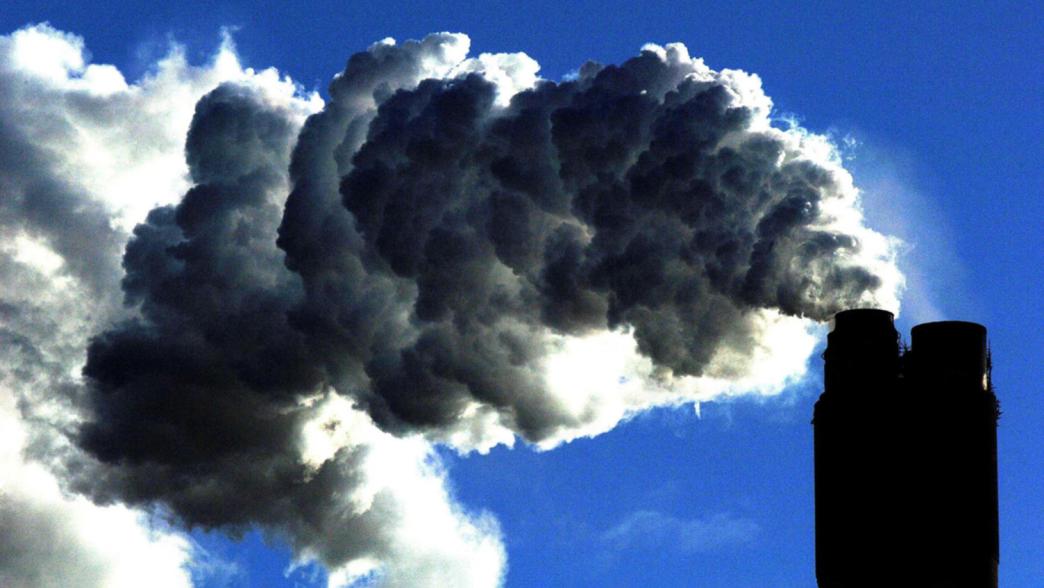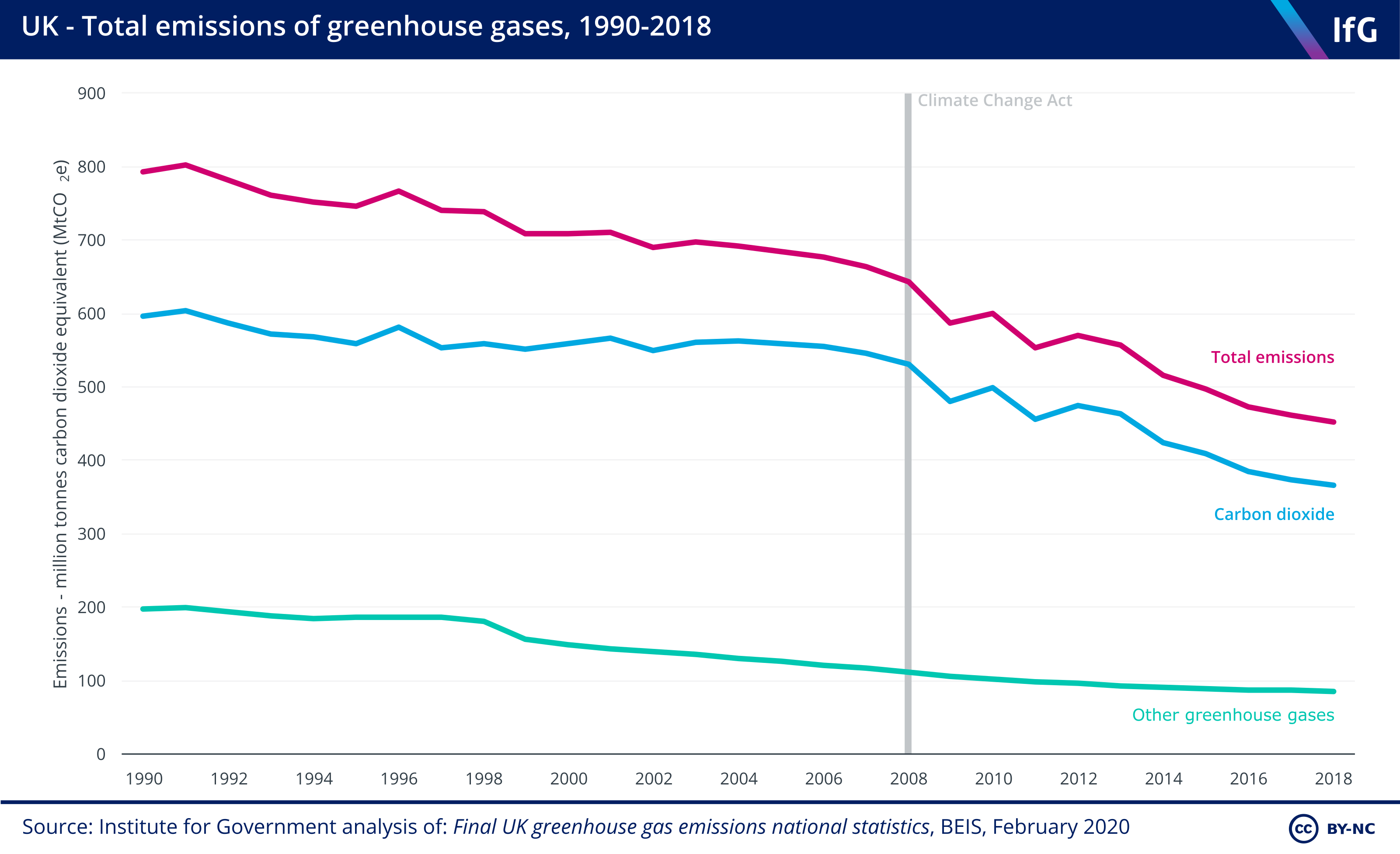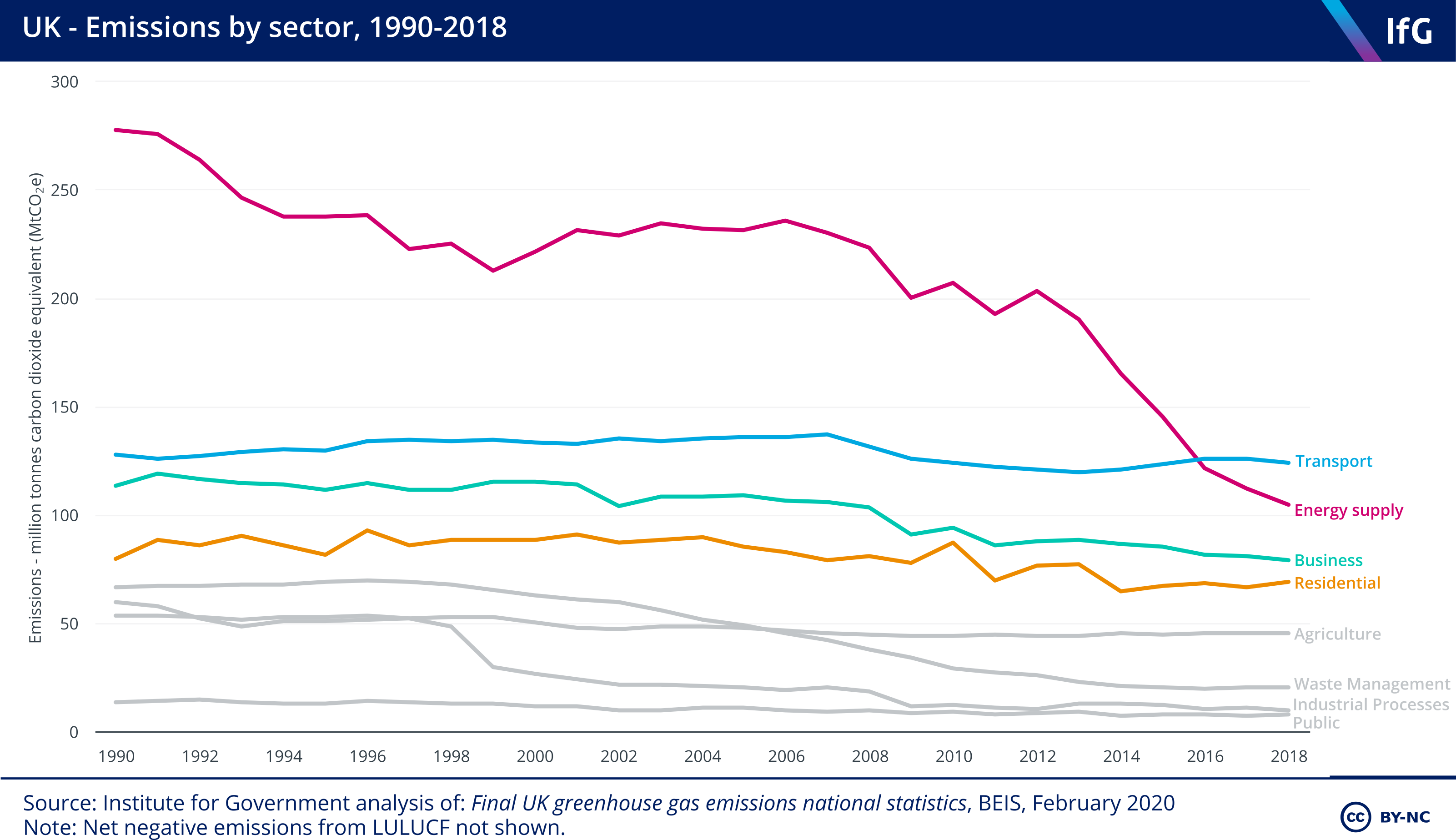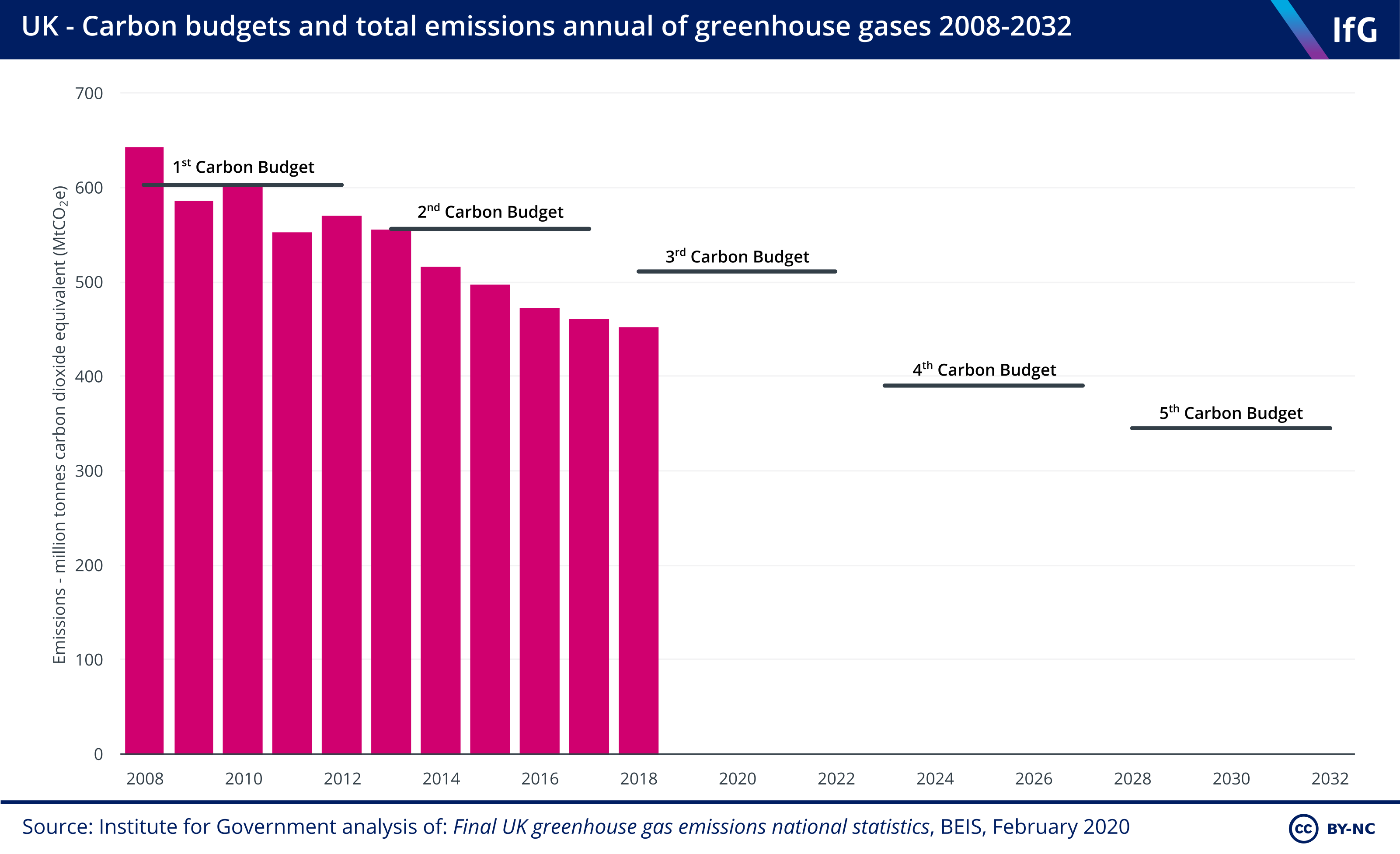UK net zero target
Net zero refers to achieving a balance between the amount of greenhouse gas emissions produced and the amount removed from the atmosphere.

In June 2019, parliament passed legislation requiring the government to reduce the UK’s net emissions of greenhouse gases by 100% relative to 1990 levels by 2050. 46 The Climate Change Act 2008 (2050 Target Amendment) Order 2019, available at www.legislation.gov.uk/uksi/2019/1056/contents/made Doing so would make the UK a ‘net zero’ emitter. Prior to this, the UK was committed to reducing net greenhouse gas emissions by at least 80% of their 1990 levels, also by 2050.
What does ‘net zero' mean?
Net zero refers to achieving a balance between the amount of greenhouse gas emissions produced and the amount removed from the atmosphere.
There are two different routes to achieving net zero, which work in tandem: reducing existing emissions and actively removing greenhouse gases.
A gross-zero target would mean reducing all emissions to zero. This is not realistic, so instead the net-zero target recognises that there will be some emissions but that these need to be fully offset, predominantly through natural carbon sinks such as oceans and forests. (In the future, it may be possible to use artificial carbon sinks to increase carbon removal. Research into these technologies is ongoing.)
When the amount of carbon emissions produced are cancelled out by the amount removed, the UK will be a net-zero emitter. The lower the emissions, the easier this becomes.
What are the UK’s greenhouse gas emissions?
The Climate Change Act 2008 47 Full text available at www.legislation.gov.uk/ukpga/2008/27/section/24 named six major greenhouse gases: carbon dioxide, methane, nitrous oxide, hydrofluorocarbons, perfluorocarbons and sulphur hexafluoride. 48 In addition to this the government also tracks and reports emissions of Nitrogen trifluoride. Carbon dioxide makes up the bulk of these. This is principally produced by burning fossil fuels in, for example, coal power stations; the main sources for the other greenhouse gasses include industrial processes and waste management, such as agriculture and landfill sites. Combined, these accounted for around 19% of all UK emissions in 2018.
The UK’s emissions of all greenhouse gases have been falling steadily over the past 30 years, though levels have risen globally. In 2018, UK emissions stood at 57% of their 1990 levels.

Why is the government trying to achieve net zero?
In May 2019, the Committee on Climate Change (CCC), a non-departmental public body that advises the government on the climate, recommended that the UK should aim to be net zero on all greenhouse gases by 2050. This would keep the UK in line with the commitments it made as part of the 2016 Paris Agreement to keep global warming under 2 degrees.
However, the UK’s existing Nationally Declared Contribution (NDC), a central pillar of its commitment to the Paris Agreement, does not commit the UK to net zero – this will likely be changed in the run up to the next COP climate talks. The CCC has concluded that “net-zero is necessary, feasible and cost-effective”. 56 Committee on Climate Change, Net Zero The UK’s contribution to stopping global warming, 2 May 2019, retrieved 03 March 2020, www.theccc.org.uk/publication/net-zero-the-uks-contribution-to-stopping-global-warming/
The UK makes up less than 1% of global emissions. By demonstrating a path to net zero, the UK hopes to set an example that others can follow. Chris Skidmore, when minister for energy and clean growth, stated that the UK was:
“pioneering the way for other countries to follow in our footsteps, driving prosperity by seizing the economic opportunities of becoming a greener economy”. 57 Department for Business, Energy & Industrial Strategy, UK becomes first major economy to pass net zero emissions law, 27 June 2019, GOV.UK, retrieved 1 April 2020, www.gov.uk/government/news/uk-becomes-first-major-economy-to-pass-net-zero-emissions-law
A strong domestic record is also vital to the UK’s credibility when it tries to persuade other countries to commit to their own efforts on climate change.
The government also recognises that climate change is an existential threat and that there is a moral case stemming from the UK’s history as a major producer of greenhouse gases. Michael Gove, a former environment secretary, has described the UK as having a “moral responsibility” to lead the international effort against climate change, due to its role in the industrial revolution. 58 Carbon Brief Daily Briefing, Industrial Revolution means UK has moral responsibility to lead on climate change, Michael Gove says, 12 February 2020, CarbonBrief, retrieved 4 March 2020, www.carbonbrief.org/daily-brief/industrial-revolution-means-uk-has-moral-responsibility-to-lead-on-climate-change-michael-gove-says
The UK will also hope to benefit from ‘first-mover advantages’ in embracing its net-zero targets early, for instance by taking a lead in developing specific technical innovations. 59 Foreign & Commonwealth Office, Foreign Secretary speech on climate change, 10 October 2014, GOV.UK, retrieved 1 April 2020, www.gov.uk/government/speeches/foreign-secretary-speech-on-climate-change
What is the legal status of the net-zero target?
The Climate Change Act 2008 committed the UK to an 80% reduction in carbon emissions relative to the levels in 1990, to be achieved by 2050. In June 2019, secondary legislation was passed that extended that target to “at least 100%”.
While the amended Climate Change Act imposes a legal obligation on the government, it is not clear how this will be enforced. The proposed Office for Environmental Protection would have enforcement powers – and the courts have also shown they are willing to intervene where they do not think the government has taken proper account of its climate change commitments. This happened in February 2020, for example, when the UK Court of Appeal ruled that the government’s policy statement in favour of Heathrow expansion was unlawful.
Is the 2050 net-zero target feasible?
The UK is currently not on track to meet its previous, less ambitious, target of 80% emissions reductions by 2050. The CCC has said that getting to net zero (i.e. meeting the 100% target) is “technically feasible but highly challenging”. 60 Committee on Climate Change, Net Zero The UK’s contribution to stopping global warming, 2 May 2019, retrieved 03 March 2020, www.theccc.org.uk/publication/net-zero-the-uks-contribution-to-stopping-global-warming/ Doing so will require sustained policy interventions across several sectors – many of which will be complex, costly and time-consuming.
And the initial signs are not positive: in its July 2019 progress report, the CCC said the UK government’s policy actions “[fell] well short of those required for the net-zero target”. 61 Committee on Climate Change, Reducing UK emissions: 2019 Progress Report to Parliament, 10 July 2019, retrieved 03 March 2020, https://www.theccc.org.uk/publication/2022-progress-report-to-parliament/ The UK is also not on track to meet some of its pre-existing future carbon budgets, set before the net-zero target was adopted (more on carbon budgets is found below).
The government has announced some policy changes in response, such as bringing forward the ban on the sale of new petrol and diesel cars from 2040, but more is needed. 62 BBC News, Petrol and diesel car sales ban could start in 12 years, says Shapps, 12 February 2020, retrieved 10 March 2020, www.bbc.co.uk/news/business-51474769
Which sectors will be most affected by net zero?
The four highest-emitting sectors are transportation, energy supply (generating electricity from burning fuels such as coal, oil and natural gas), business (commercial use of electricity), and residential (heating homes). Together these account for around 78% of current emissions.

Since 1990, the UK has achieved steep emissions reductions in the energy-supply sector, historically the worst offender, particularly in the last eight years as a result of phasing out coal and increasing the use of renewables, such as wind and solar. But in other areas – such as transport, homes and agriculture – emissions remain largely unchanged. Decarbonising these areas will be more difficult.
Some regions of the UK will also find getting to net zero more achievable than others. The Scottish government has set itself a target of net zero by 2045 in line with recommendations by the CCC. 66 Scottish Government, Scotland to become a net-zero society, 25 September 2019, GOV.SCOT, retrieved 4 March 2020, www.gov.scot/news/scotland-to-become-a-net-zero-society, Scottish Government, Climate change, GOV.SCOT, retrieved 1 April 2020, www.gov.scot/policies/climate-change/reducing-emissions Its abundant land, with potential for afforestation (planting trees to create forests, which are natural carbon sinks), means it has more potential capacity to remove emissions from the atmosphere than the rest of the UK. 67 Committee on Climate Change, Net Zero The UK’s contribution to stopping global warming, 2 May 2019, retrieved 03 March 2020, www.theccc.org.uk/publication/net-zero-the-uks-contribution-to-stopping-global-warming
In contrast, Wales has a much more difficult path to reach net zero, even by 2050, in part because it has high agricultural emissions. 68 Ibid. The CCC recommended that Wales aim for a 95% reduction by 2050, which the Welsh government accepted. This wouldn’t stop the UK as a whole from being net zero by 2050.
What are carbon budgets?
The Climate Change Act 2008 requires the government to set five-yearly carbon budgets, after taking advice from the CCC. These run until 2032. The budgets are fixed in advance and set five-year caps on the total greenhouse gas emissions allowed to ensure the UK meets its emissions reductions commitments. The UK is on track to meet its third carbon budget (the current one, covering 2018–22) but is not on track to meet its fourth (2023–27) and fifth (2028–32).

The CCC will advise the government on the sixth carbon budget (2033–37) in September 2020. 77 Committee on Climate Change, CCC to publish Sixth Carbon Budget in September 2020, 17 October 2019, retrieved 10 March 2020, www.theccc.org.uk/2019/10/17/ccc-to-publish-sixth-carbon-budget-in-september-2020 This will be the first to take the net-zero target into account. However, the carbon budgets currently exclude emissions from international aviation and shipping (those produced by planes and ships while in UK territorial waters and airspace). Accurately measuring the UK’s share of these is difficult, but the advice from the CCC is that the final net zero target should account for such emissions. 78 Committee on Climate Change, Letter International aviation and shipping and net zero, 24 September 2019, retrieved 1 April 2020, www.theccc.org.uk/publication/letter-international-aviation-and-shipping
Does the UK have to reach its target only though domestic efforts?
The carbon budgets allow for the use of international carbon units traded outside the EU’s Emissions Trading System (ETS). 79 Priestly S, UK Carbon Budgets, 9 July 2019, House of Commons Library, Briefing Paper CPB 7555, retrieved 04 March 2020, https://researchbriefings.parliament.uk/ResearchBriefing/Summary/CBP-7555 Participating in this system means that the UK may produce more emissions than are accounted for, as some can be offset by trading ‘carbon credits’ with other countries. The government has stated that the UK will remain a part of EU ETS until January 2021. 80 Department for Business, Energy & Industrial Strategy, Meeting climate change requirements from 1 January 2021, 4 November 2019, GOV.UK, retrieved 04 March 2020, www.gov.uk/government/publications/meeting-climate-change-requirements-if-theres-no-brexit-deal/meeting-climate-change-requirements-if-theres-no-brex…
What are the costs – and benefits – of reaching net zero by 2050?
Reaching net zero will bring the UK important benefits – but will incur large costs. Estimating either of these with any accuracy is difficult, given the level of uncertainty around new and emerging technologies, and changes in the economy and people’s behaviour.
In 2019, the CCC estimated that the total costs of getting to net zero would be £50bn per year, less than 1% of projected GDP over that period. The Treasury and the Department for Business, Energy and Industrial Strategy (BEIS) put the figure at £70bn per year, or over £1 trillion by 2050. 81 Committee on Climate Change, Net Zero: The UK’s contribution to stopping global warming, 2 May 2019, retrieved 03 March 2020, www.theccc.org.uk/publication/net-zero-the-uks-contribution-to-stopping-global-warming The economic analysis of net zero will undoubtedly change in the wake of the coronavirus pandemic, however.
Models that attempt to calculate costs have a degree of uncertainty because the underlying economics are constantly shifting. One example is the changing price of offshore wind, whose cost fell by over 30% in 2019 alone, greatly exceeding expectations. This suggests that the UK could potentially accelerate moves to electrify other parts of the economy that have previously relied on energy from fossil fuels, such as surface transport and heating for homes and offices. 82 Evans S, Analysis Record-low price for UK offshore wind cheaper than existing gas plants by 2023, 20 September 2019, CarbonBrief, retrieved 4 March 2020, www.carbonbrief.org/analysis-record-low-uk-offshore-wind-cheaper-than-existing-gas-plants-by-2023
Net zero will also bring wider societal benefits, for instance to human health as a result of improved air quality and a better-protected natural environment. The CCC says these could “partially or fully offset costs”, for instance by reducing hospital admissions, and enabling people to be more productive. 83 Committee on Climate Change, Net Zero The UK’s contribution to stopping global warming, 2 May 2019, retrieved 03 March 2020, www.theccc.org.uk/publication/net-zero-the-uks-contribution-to-stopping-global-warming In November 2019, the Treasury launched a review into the costs and opportunities of reaching net zero, this is due to report in late 2020. 84 Full details can be found at www.gov.uk/government/publications/net-zero-review-terms-of-reference/hm-treasurys-review-into-funding-the-transition-to-a-net-zero-greenhouse-gas-ec…
Which other countries have set net zero targets?
Six nations have passed laws formally establishing net zero targets: Sweden and Scotland by 2045, and the UK (as a whole), France, Denmark and New Zealand by 2050. Similar legislation has been proposed in the EU, Spain, Chile and Fiji. The UK was the first G7 nation to legislate for this.
Many other countries have set targets, most at 2050 (Norway is aiming for 2030) but are yet to propose or pass legislation formalising these into law. The only countries which are currently net negative are Bhutan and Suriname.
- Topic
- Net zero
- Keywords
- Climate change Environment Energy
- Publisher
- Institute for Government